|
|
A
Close-up View of the "Staghorn Sumac" (Rhus typhina) |
|
|
A
Close-up View of the "Staghorn Sumac" (Rhus typhina) |
The
staghorn sumac is a small tree that commonly grows in large groups in
the wild. It is often used by landscapers as a decorative
addition to residential yards and municipal parks. Its common
name is derived from the fact that the branches are covered by dense,
extremely soft hairs, and resemble the "velvet" on a deer’s
antlers. As well as being decorative, the trees are a source of
seeds for both songbirds and gamebirds during cold Canadian
winters. Historically, Native American Indians made a drink from
the plant’s crushed fruit. The tannin-rich bark and leaves also
provided tanneries with a natural tanning agent.
It is interesting to note that a sumac tree is either male or female,
but not both. This trait is referred to as “dioecious”.
The “Male” Sumac Tree
The image below shows part of a male tree. The yellow-green
pyramidal structure at the center of the image is called a panicle, and
consists of many tiny flowers.
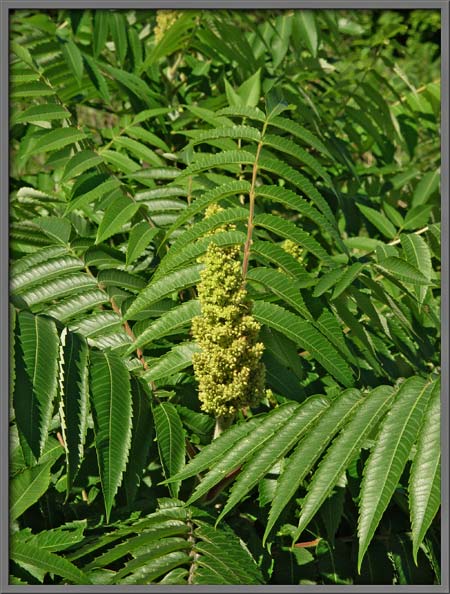
Sumac leaves are compound, and the toothed leaflets are positioned on
the stem opposite one another.
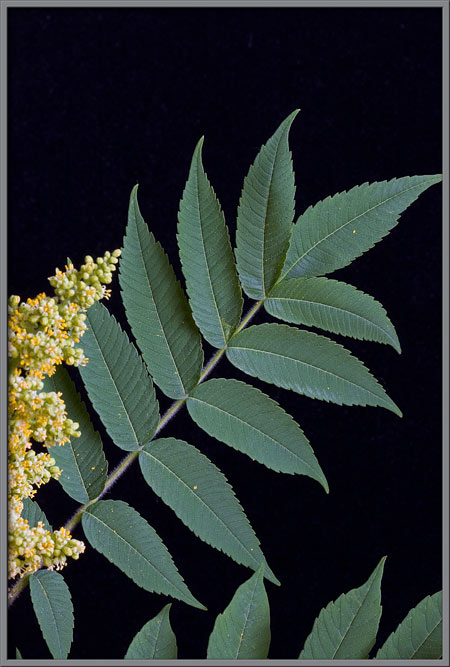
A high magnification reveals the multitude of tiny white hairs that
cover the stems. It is these hairs that give the plant its common
name “staghorn”.
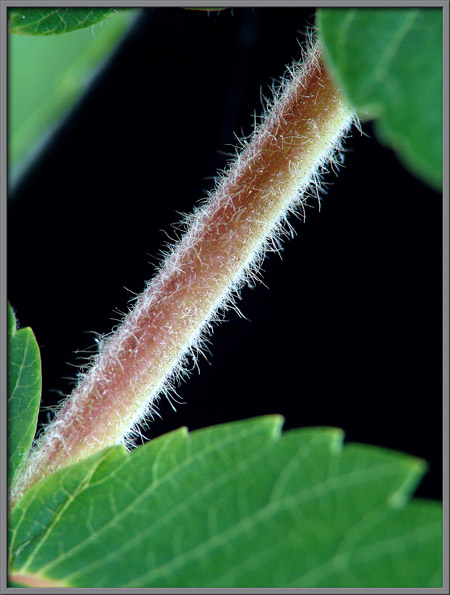
The toothed edges of a leaf are clearly visible below. Notice in
the image of the back of a leaf, that the sturdy white rib has many
tiny hairs on its surface.
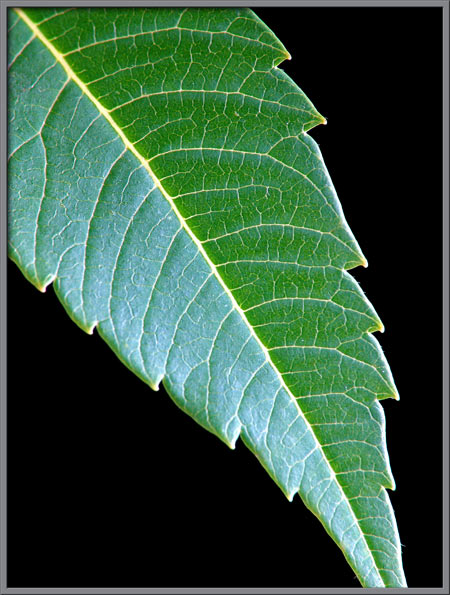
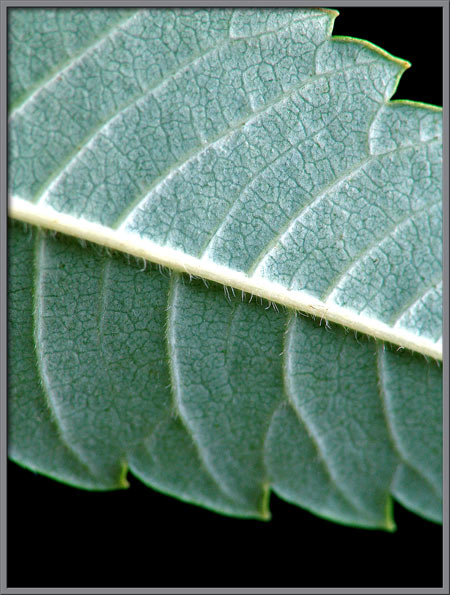
In June and July, the male sumac trees are covered with panicles of
flowers like the one below. The closer view on the right just
begins to resolve individual flowers.
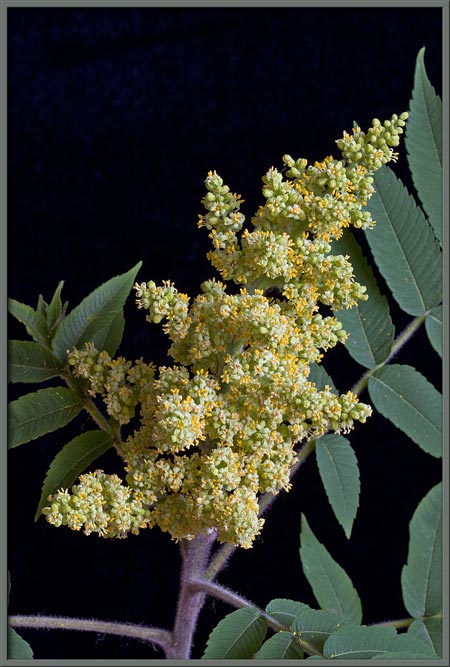
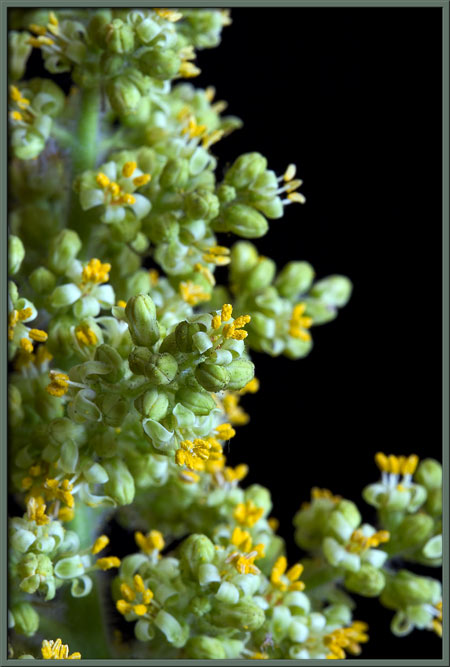
The image on the left below shows many unopened buds, as well as a few
mature flowers. If you look carefully at the central flower in
the right hand image, you can see five light green petals, five bright
yellow-orange anthers (male,
pollen producing organs), and, at the
exact center, three circular pale yellow structures that form the
stigma (female, pollen
accepting organ). Surprise! You
might expect the flowers of the male staghorn tree to have only
anthers. In reality most flowers are “perfect” (they have both
stamens & pistils).
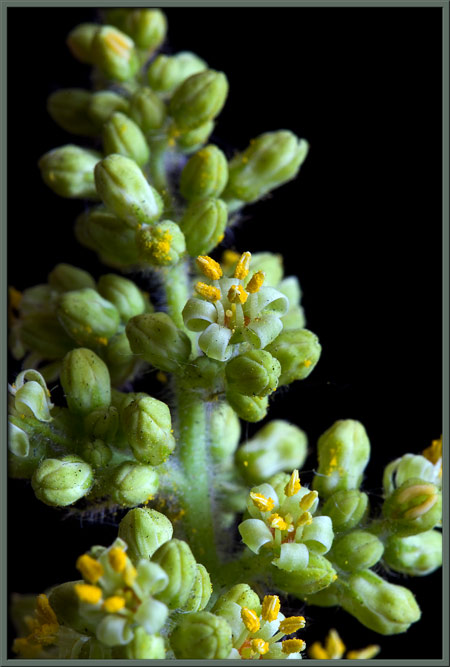
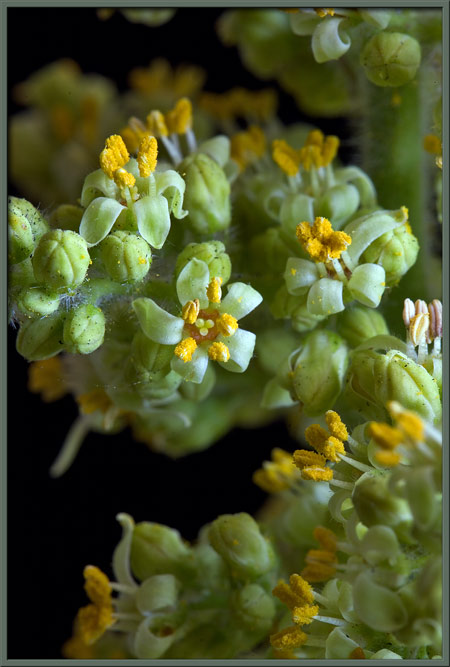
Each staghorn sumac flower is 4 to 5 mm in diameter. In many
flowers there is a hint of reddish-brown at the very center.
Note: The back end of a
visiting insect with almost perfect
camouflage colouration can be seen at the right edge of the first
image, just below the mid-point.
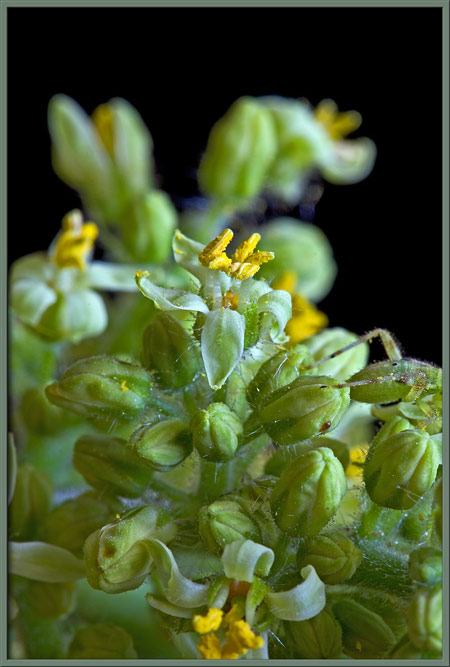
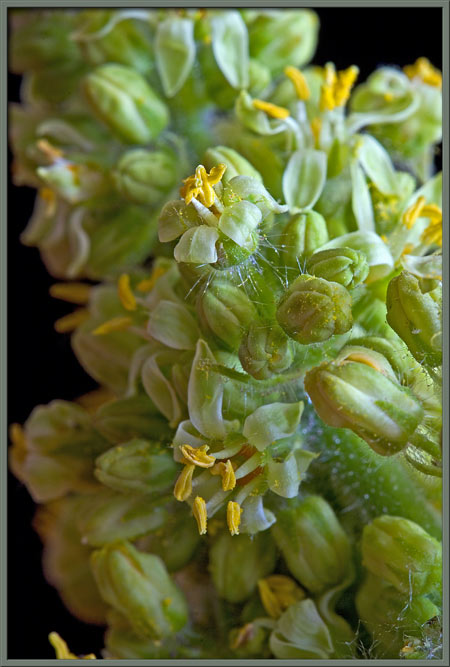
It is evident below that each anther is divided longitudinally by a
deep groove.
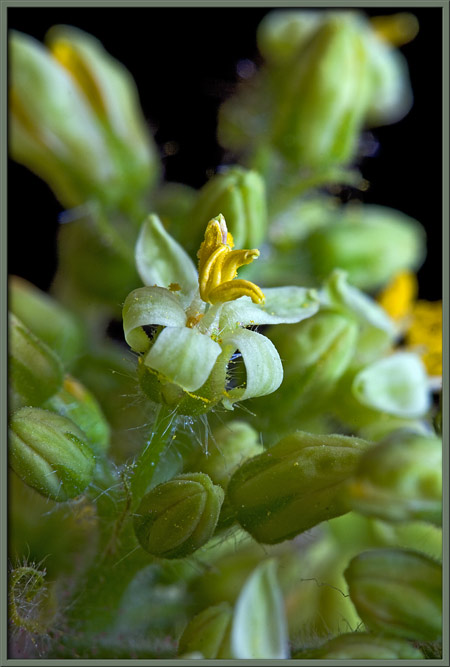
At higher magnification, the pale white filament supporting each anther
becomes visible. The orange-brown center of a flower can be seen
in the right hand image.
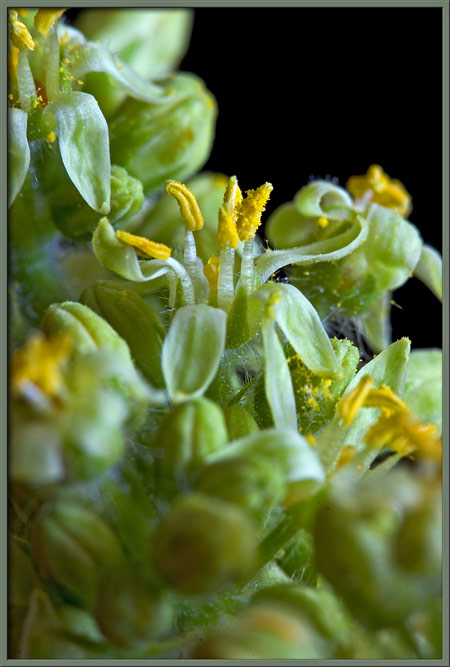
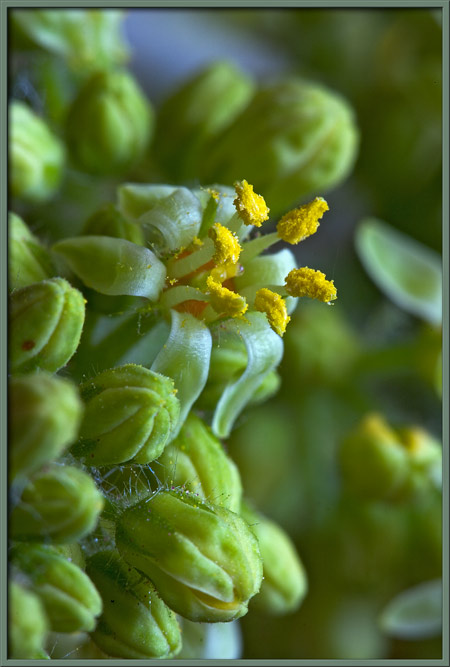
Under the microscope, the deep groove at the center of an anther can be
seen to be filled with pollen grains. The right hand image shows
the grains to be ellipsoidal in shape.
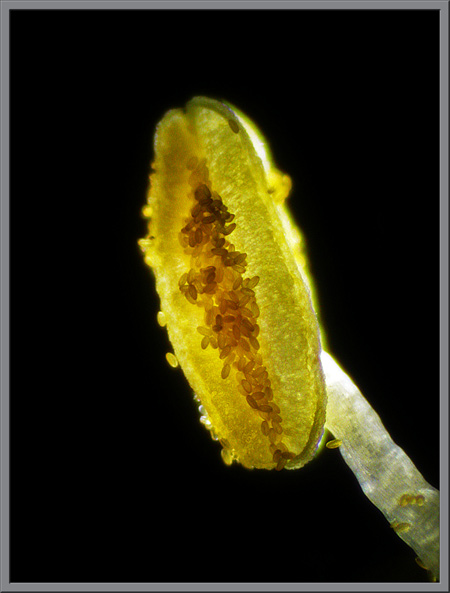
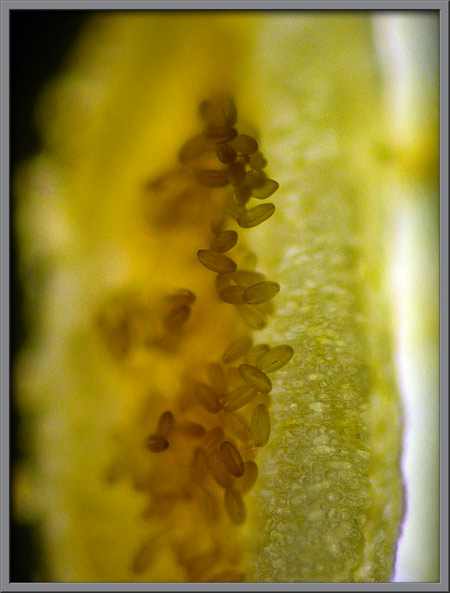
Pollen grains stick to the surface of the filament supporting the
anther.
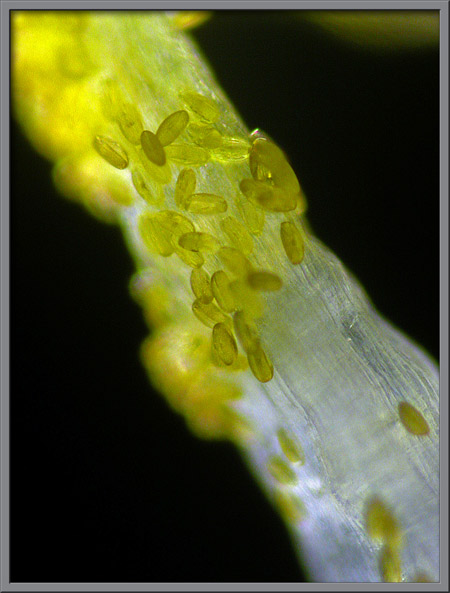
For some reason, some pollen grains are stuck together in long “chains”.
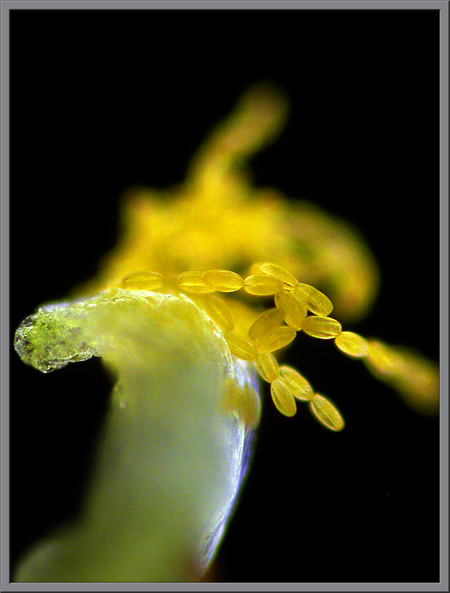
Others can be seen below, adhering to form a convex shape.
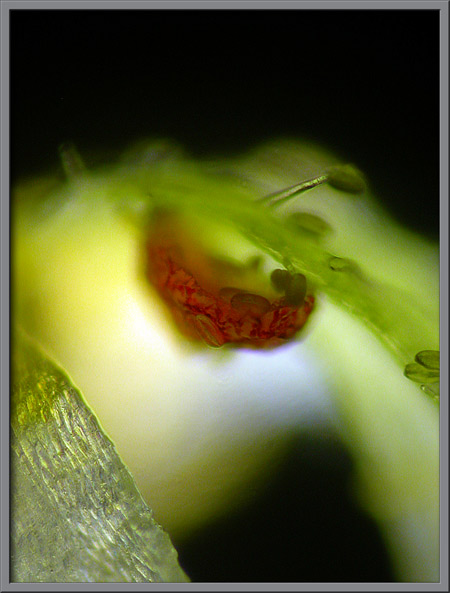
Phase-contrast illumination shows the rough surface, and longitudinal
groove of each grain.
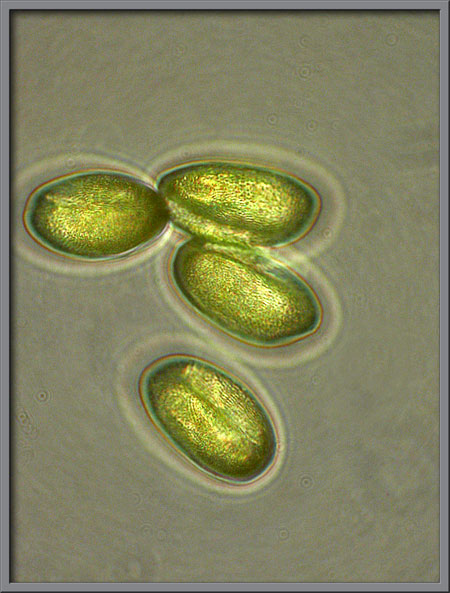
At the very center of the flower, there is a three-lobed stigma
supported by a three-columned style.
It is interesting to note
the almost perfectly spherical tip of each stigma lobe, and the way in
which each sphere is clasped by the style. The nature of the
orange colouration at the base of the stigma-style is revealed in the
image on the right. The centers of the cells forming the tissue
are orange in colour.
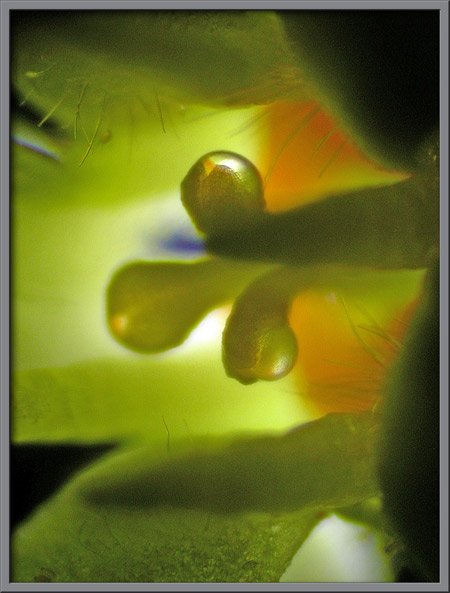
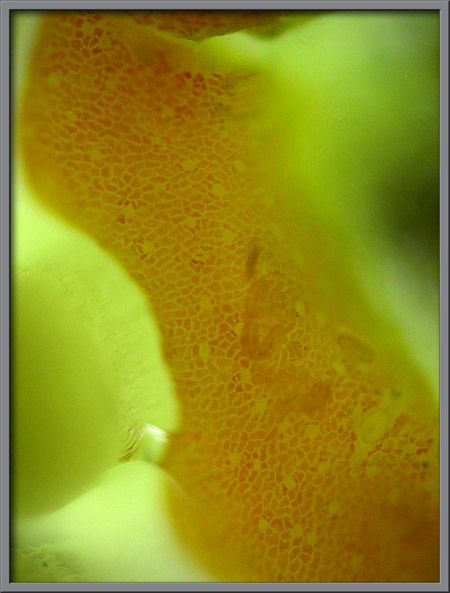
Once the flowers have finished blooming on the male sumac tree, they
shrivel up and drop off. For the rest of the growing season, the
tree has only leaves; it does not develop the colourful “fruit”
of the female tree discussed below.
The “Female” Sumac Tree
The pyramidal panicles of flowers on the female tree are less random in
shape than on the male counterpart. A typical such panicle can be
seen below, shortly after the flowers have finished blooming.
Notice in both images, how densely packed the flowers are in a panicle.
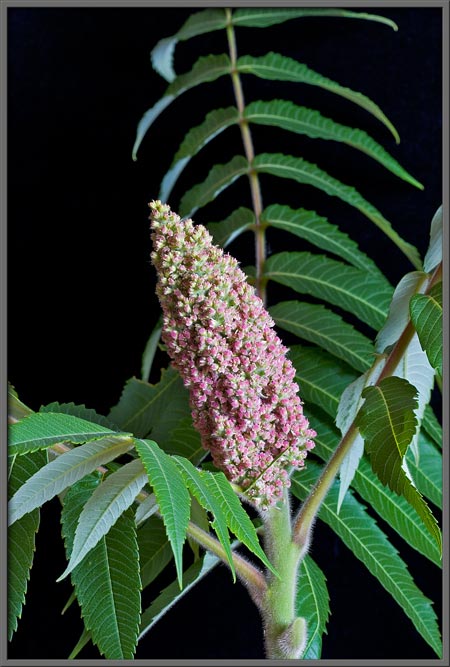
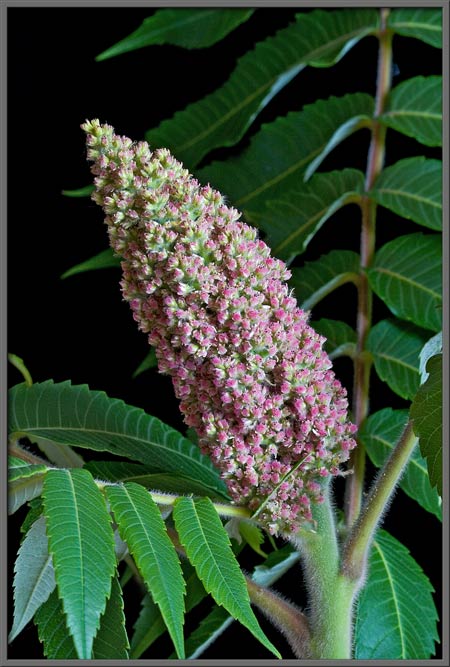
A closer view shows the dense packing of the many reddish drupes
(fruit) that form the panicle. Notice the three black dots at the
top of each drupe. These are the darkened tops of each
three-lobed stigma. Each drupe contains a single seed with a hard
coating. The mature drupes may last through the winter, if they
are not eaten by birds. They eventually turn dark brown.
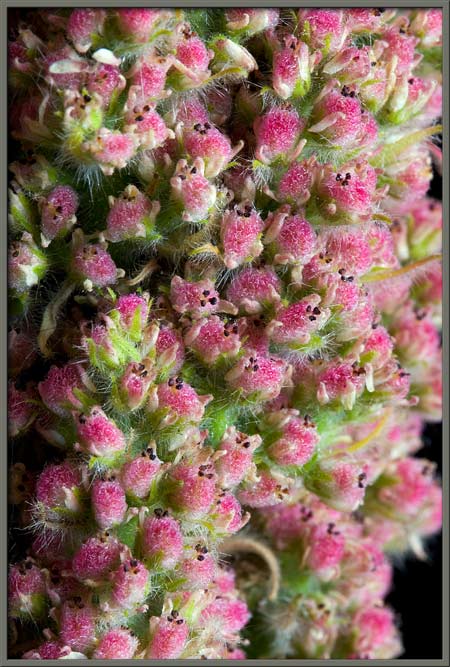
Higher magnification reveals more structural detail. At the base
of the pistil (stigma-style),
the ovary has swollen into a red, roughly
spherical fruit, topped by the darkened stigmas, and circled by the now
beige-green petals . Each flower has a multitude of fine hairs at
its base.
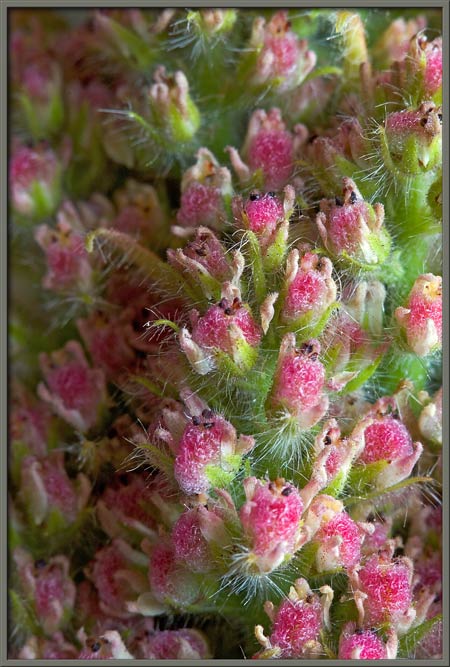
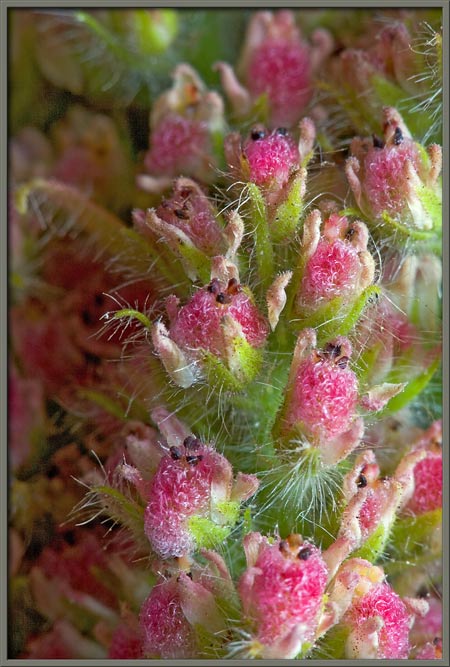
The following sequence of images was taken a year earlier than the
former ones. The panicles of fruit are several weeks “older” than
those shown before.
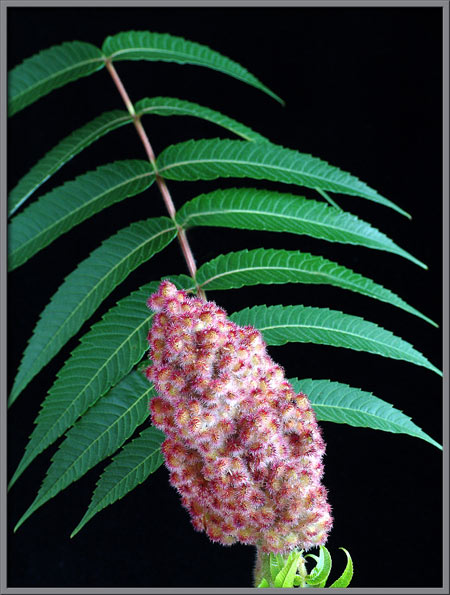
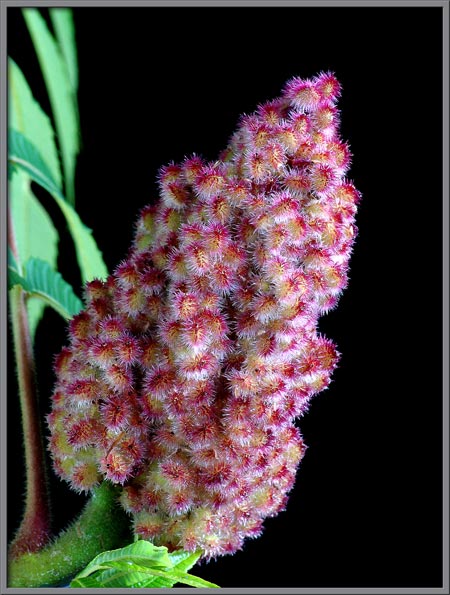
At this later stage, most of the blackened stigmas have fallen from the
flowers, leaving only the swollen fruit. Each drupe is yellow in
colour, but it is covered with groups of dense bright red hairs that
are stuck together at their tips. What an extraordinary fruit the
staghorn sumac possesses!
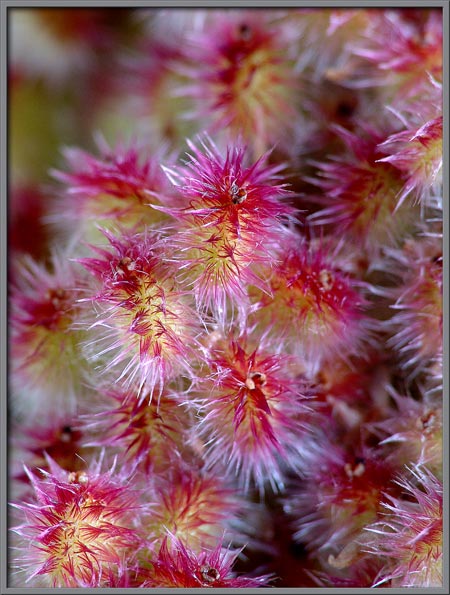
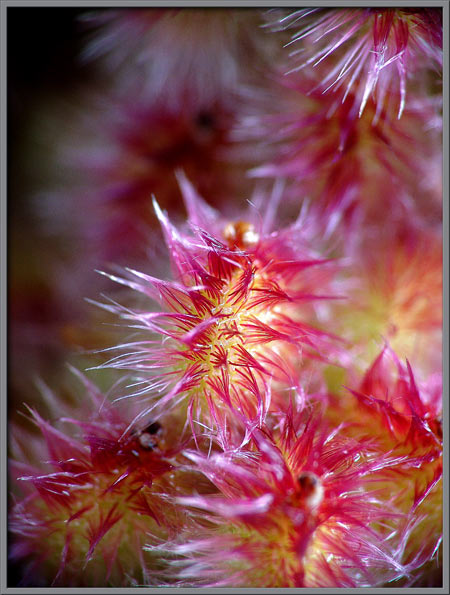
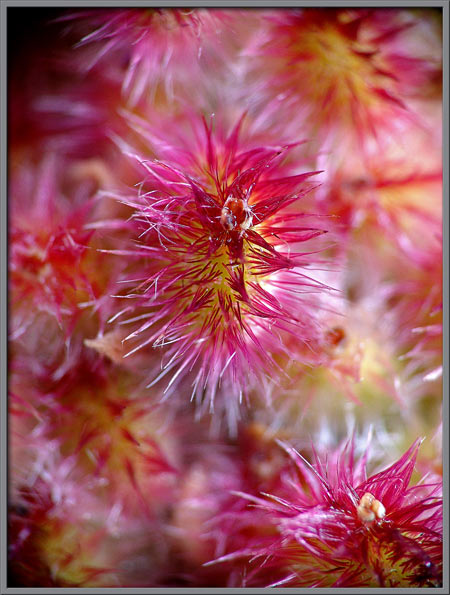
A year after the preceding images were taken, I went back to the same
tree and had another look at a panicle of drupes.
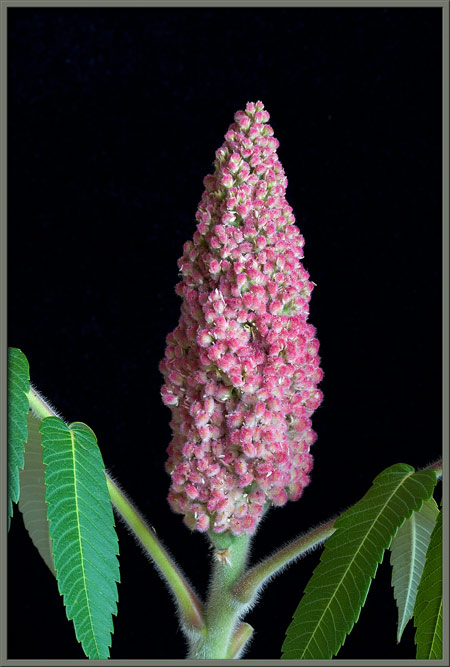
This time, notice that the drupes have swollen to the point that they
now dwarf the remaining flower petals.
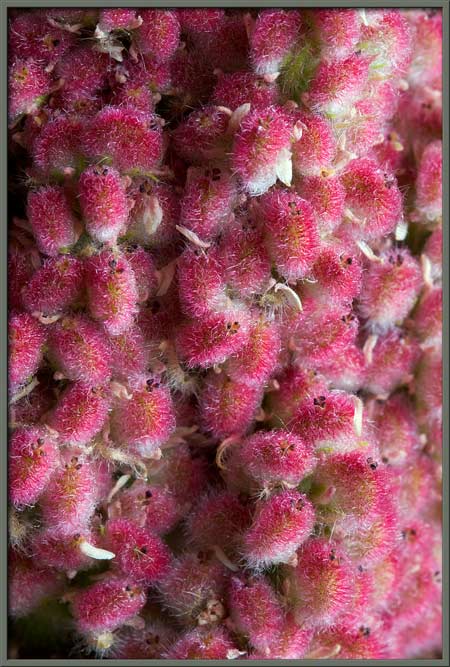
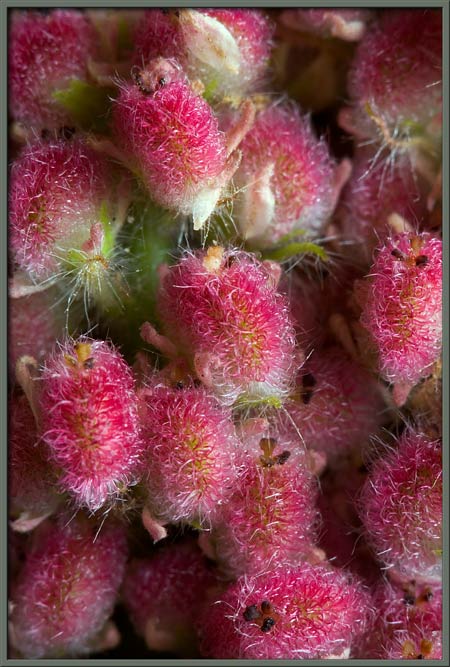
Staghorn sumac is highly prized for the coloration of its fruit, and
its brilliant autumn foliage. It is unfortunate that the display
of coloured leaves (see below) lasts for such a short time. The
late autumn winds soon blow them from their branches, leaving only a
network of red stems and the darkening panicles of fruit.
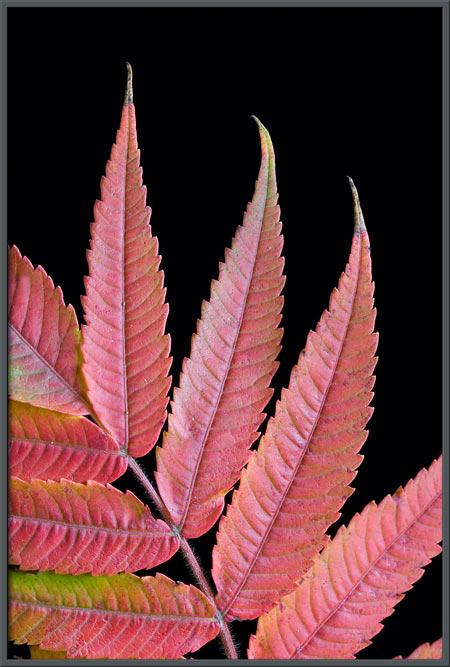
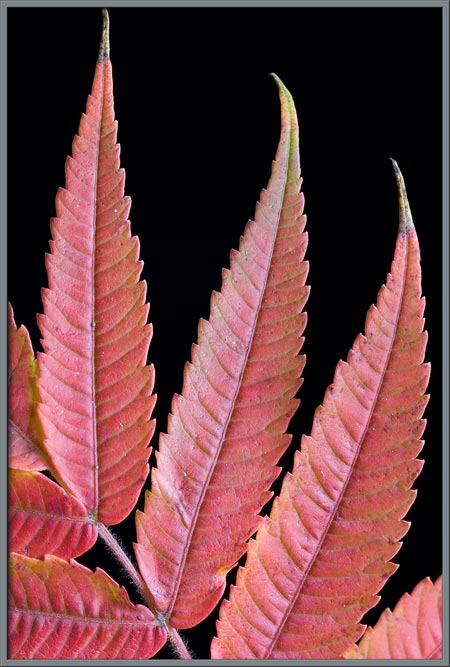
Photographic Equipment
About half of the photographs in the article were taken with an eight
megapixel Canon 20D DSLR and Canon EF 100 mm f 2.8 Macro lens. An eight
megapixel Sony CyberShot DSC-F 828 equipped with achromatic close-up
lenses, (Nikon 6T, Sony VCL-M3358, and shorter focal length achromat
used singly or in combination), was used to take the rest of the macro
images. The lenses screw into the 58 mm filter threads of the camera
lens. Still higher magnifications were obtained by using a macro
coupler (which has two male threads) to attach a reversed 50 mm focal
length f 1.4 Olympus SLR lens to the F 828. (The photographs in the
article were taken over a two year period.) The photomicrographs were
taken with a Leitz SM-Pol microscope (using a dark-ground condenser),
and a Nikon Coolpix 4500 camera.
References
The following references have been
found to be valuable in the identification of wildflowers, and they are
also a good source of information about them.
Published in the July
2007 edition of Micscape.
Please report any Web problems or
offer general comments to the Micscape
Editor.
Micscape is the on-line monthly magazine
of the Microscopy UK web
site at Microscopy-UK
© Onview.net Ltd, Microscopy-UK, and all contributors 1995 onwards. All rights reserved. Main site is at www.microscopy-uk.org.uk with full mirror at www.microscopy-uk.net .